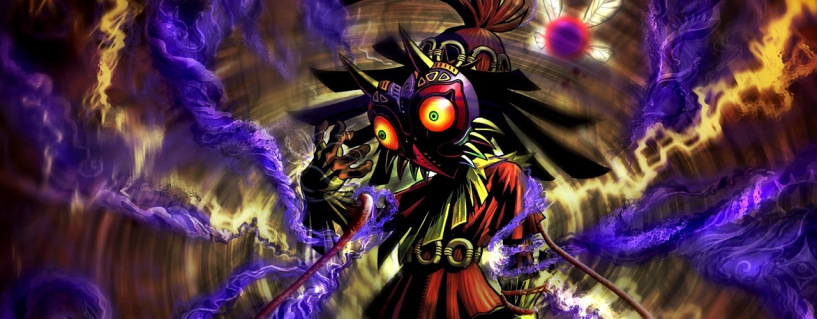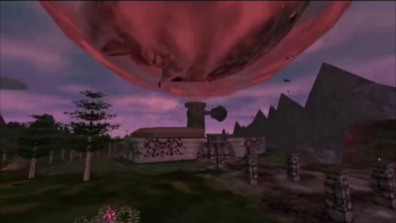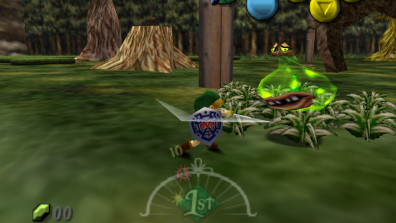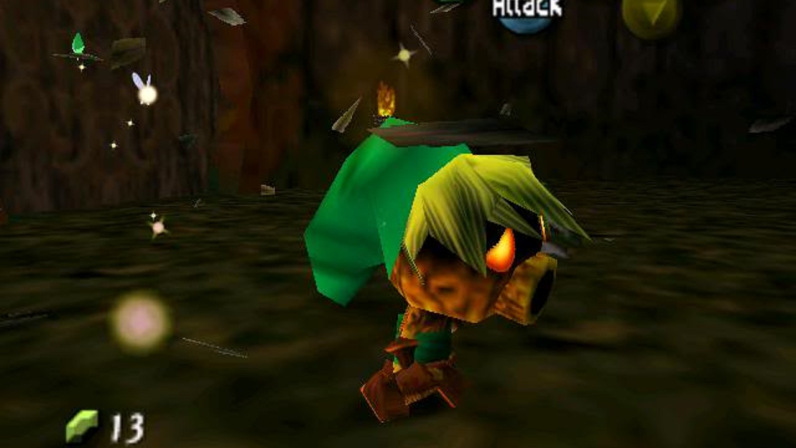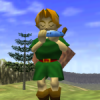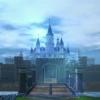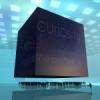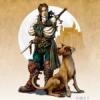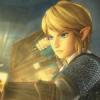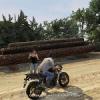The sixth mainline installment in the Legend of Zelda series, Majora’s Mask presented a much darker tone when compared to its forebears. Typically the Zelda games are set in Hyrule, but Majora’s Mask took us instead to the land of Termina, a place where the Skull Kid had stolen Majora’s Mask – an ancient, powerful artifact – and caused the land’s moon to slowly fall towards Termina, where it will crash in three days.
Majora’s Mask follows Link through his adventures in time as he constantly travels back to the first of those three days in an an epic quest to find a way to stop the moon from destroying the world, and saving its inhabitants. All of this is made possible by the use of various masks, some of which allow Link to transform into other beings. Along the way, he learns how to play several new tunes on his ocarina, which in turn also gives him the ability to control the flow of time or open passages to one of four temples within the game - each offering a new challenge to overcome.
Majora’s Mask opens with a Link suffering a heavy loss. Navi, his closest friend, is missing, and in his grief, Link sets out on an adventure to find her. As an emphasis of his complete feeling of loss, he finds himself within the Lost Woods, on the far edges of Hyrule. Here, he meets Skull Kid - a being who has been outcast by his peers – a character filled with anger and a thirst for revenge. This chance meeting is what drags Link into Termina, throwing him into an endless cycle of death and grief – a place where Link is forced to come to terms with his own emotions.
While on the surface, the game seems like a simple - albeit dark - tale, just another story about saving the world, one popular interpretation among fans is that Link’s travels through Termina are a metaphor for the stages of grief. Originally proposed by Elisabeth Kübler-Ross in 1969, the theory goes that people suffering from loss travel through five distinct steps on the road to processing the trauma - Denial, Anger, Bargaining, Depression and Acceptance.
Denial
 Denial is a defensive mechanism, defined as an inability to rationally acknowledge what is really happening. After arriving in Termina through the Clock Tower – a large clock that forever ticks down to the Carnival of Time at the start of each harvest – Link begins his ultimate journey through the five stages. It’s strange that, despite the threatening moon in the sky, the people of Clock Town still go about preparing for the festival and the harvest, seemingly unwilling to accept the grim reality of their situation and instead carrying on with their lives as though nothing is wrong. Link isn’t able to do much or go to many places when he first arrives - thanks to being stuck in his Deku Scrub form - but he eventually finds himself in the Mayor’s office, where he quickly learns of the struggle that is brewing.
Denial is a defensive mechanism, defined as an inability to rationally acknowledge what is really happening. After arriving in Termina through the Clock Tower – a large clock that forever ticks down to the Carnival of Time at the start of each harvest – Link begins his ultimate journey through the five stages. It’s strange that, despite the threatening moon in the sky, the people of Clock Town still go about preparing for the festival and the harvest, seemingly unwilling to accept the grim reality of their situation and instead carrying on with their lives as though nothing is wrong. Link isn’t able to do much or go to many places when he first arrives - thanks to being stuck in his Deku Scrub form - but he eventually finds himself in the Mayor’s office, where he quickly learns of the struggle that is brewing.
You overhear the Carnival Committee talking about the looming moon, questioning whether it will really fall into them. They refuse to admit that the danger in the sky, and that death is coming. Though what you see before you seems like nothing more than a disagreement, it can easily be seen as a metaphor for denial. These people refuse to accept that something terrifying and dangerous would happen to them, so they continue as though nothing is. Of course it’s only temporary. Eventually they’re forced to face the truth as the problem becomes harder to ignore.
At the end of the three days, everyone has evacuated - save for Mutoh, a carpenter who refused to accept there was any danger, and labelled all who disagreed a coward. He opts to stay behind, hiding in a back room and trembling in fear. This leaves Link at the top of the Clock Tower, having looked for Skull Kid and now face-to-face with oblivion. Unable to do anything, he plays a song on his ocarina which rewinds events back to the beginning of the three days.
Anger
 When you can no longer deny a painful truth, you begin to direct anger and envy towards others - even if they don’t deserve it.
When you can no longer deny a painful truth, you begin to direct anger and envy towards others - even if they don’t deserve it.
After reversing the flow of time, Link travels to the Southern Swamp and upon entering, finds yet another example of grief. The Deku Tribe’s Princess is missing, and you meet the Deku King. Though he is a rather humorous character, set on punishing a young monkey, his introduction heralds the onset of the next stage of grief.
The Deku King swears upon everything that this monkey is responsible for his daughter’s disappearance, without any evidence. He will do anything to punish and kill this monkey, even though he is completely innocent.
He at least has grounds to be suspicious - the monkey had been with the Princess when she went missing. Toxic swamp water had been coming from the nearby temple, and the two were investigating it when she went missing. The Deku King chooses to direct his anger poorly though, focusing his rage on the small monkey instead of searching for his daughter. He doesn’t realize that Skull Kid’s anger and rage is what manifested in the swamp and caused the toxic flow.
After learning how to play the Sonata of Awakening on his ocarina, and lifting the temple from beneath the bog, Link watches as the temple expels the evils of anger from inside, as if in an attempt to wash away emotions. Ultimately, Link pacifies the anger and pulls the Deku King back to his senses, saving the region and the small monkey from the disastrous fate it was heading for.
Bargaining
 This is where the affected make desperate pleas to postpone or reverse the suffering and loss that they are going through. They want to regain whatever it is that they have lost, and will bargain with anyone they think can change what has happened – even if that person is themselves.
This is where the affected make desperate pleas to postpone or reverse the suffering and loss that they are going through. They want to regain whatever it is that they have lost, and will bargain with anyone they think can change what has happened – even if that person is themselves.
Link continues on his travels, and finds himself in the northern, snowy mountains of Snowhead. But he isn’t out of grief yet, as he finds the Goron tribe, who is mourning the loss of their patriarch, Darmani.
Link soon finds himself face-to-face with the ghost of Darmani. While standing above his own grave, Darmani gives Link his last request: “I beg you! Bring me back to life with your magic!”
Darmani is trying to make any deal he can to just have a little longer in life, and is hoping that Link can provide some backdoor solution.
Of course, it isn’t that simple. When is it ever? The patriarch just can’t face the fact he failed his people, and feels they will die without him; so he’s ready to beg anyone who will listen to bring him back to life, by any means.
We saw the denial in Clock Town as everyone refused to acknowledge the Moon until it was too late; We saw the anger depicted in the toxic sludge that seethed from the temple. Now, we see the icy coldness of Snowhead and their dead leader’s inability to move on. It takes Link dousing the area with the Hot Spring Water and making Darmani realize that his desperate desires can’t be granted, before the leader can find rest.
Your work isn’t finished yet though, as you put on Darmani’s disguise and take down Goht - a mechanical bull-like monster that moves in a continuous circle around his arena. Only the strength of the heroes of Goron can stop him, and Link has that strength. Goht represents a futile, circular effort to fight one’s way to a reality already lost. Defeating him puts the once endless cycle to a close, just as Darmani had brought his own hopeless desires to a halt.
Depression
 Depression is the fourth stage of grief, and comes with the overwhelming feeling that there is no way out, and all you can do is give up and hide.
Depression is the fourth stage of grief, and comes with the overwhelming feeling that there is no way out, and all you can do is give up and hide.
As Link comes to the coastline of Great Bay, he meets the dying Mikau. He learns of Mikau’s girlfriend, Lulu, and her missing eggs. Link heads over to Zora Hall, where he finds Lulu in complete isolation, staring out at the Great Bay Temple.
Lula’s isolation stems from her missing eggs. She’s a mother who has lost her young, suffering from postpartum depression. Just looking at her, you can see her despair. She simply stands immobile, staring out at sea, never speaking. In a way, it is almost as if the Great Bay is a collection of Lulu’s tears.
The only way to pull Lulu out of this state is to sing the song that was born from her offspring, to return a small part of what was lost. It is said that naming a lost child can help with closure, and ease the pain. Singing this song for Lulu helps her find closure, as each note of the song represents a single egg from her nest..
Acceptance
 After traveling through every other stage of grief, all that is left is to examine yourself and the reality around you and face the future with a new outlook.
After traveling through every other stage of grief, all that is left is to examine yourself and the reality around you and face the future with a new outlook.
Link finds this acceptance in Ikana Valley – the land of the dead. Every region in Majora’s Mask is filled with colorful characters and people, life and vibrant emotions. But here in Ikana Valley, everyone except for a young girl and her mummified daughter is dead. Here, there is nothing for Link to gain, no masks to find and no new transformations. Everything is desolate, and real. There is only one thing here to focus on, the one thing he’s fought to ignore this entire journey: himself.
Link starts his journey towards acceptance by climbing a tower that leads into the heavens above, where he’s forced to create images of himself to continue on. He creates one for each of his forms, but they are lifeless and have no personality. They represent the empty shells of the previous stages of grief. He must leave each behind as he climbs the tower, only able to gain enlightenment – the Light Arrows – at its summit.
Only then does the tower flip, placing the heavens at Link’s feet, symbolizing his ascendance. Throughout the Stone Tower, Link battles Garo Masters – described as emptiness cloaked in darkness. They commit suicide every time you defeat them, refusing to accept death on anyone’s terms except their own. Link duels with them as he climbs towards the light that signifies the ongoing struggle between hope and despair, all while battling to triumph over the emptiness associated with his twin selves. Only once he has accepted and overcome his grief is he able to demonstrate he’s no longer troubled by the loss of Navi. He has found who he really is, his true self.
Throughout all of the events in Majora’s Mask, we learn of Skull Kid and how he was once friends with the Four Giants. But when Skull Kid faced losing the Giants to their slumber in the four corners of the world, Skull Kid slipped in to grief and despair. He began to torment the four lands, losing his friends in the process. This grief and anger is what was absorbed into Majora’s Mask. So when Link comes to finally face Skull Kid at the top of Clock Tower at the game’s climax, the mask takes on a life and a personality of its own.
Link must give up each of the masks that he collected in his journey, proving he has successfully overcome each stage of grief. The power that he gains from this act is stronger than that of the enemy before him, and he easily vanquishes the evil of grief and despair from his foe’s mind. With Skull Kid freed from the weight of his loss, he is able to reconcile with friends and find peace. Link and Skull Kid return to the Lost Woods as friends.
The grief theory is almost too well placed. You travel through five areas and the NPCs and their interactions pair up perfectly with Kübler-Ross’ original model. But there’s a further theory, and it stems around questioning what it actually is that Link is grieving in the first place. This brings us to the final point of exactly why Majora’s Mask is ultimately the darkest, and saddest Legend of Zelda games. The theory proposes that Link is actually dead and on a voyage through purgatory, the waiting room of the afterlife. It posits that Majora’s Mask is actually Link’s personal quest to seek acceptance of his own death and move on.
Perhaps supporting this theory is the name of the world in which Majora’s Mask takes place: Termina, meaning the end. Let’s not forget how exactly Link came to find this place. Falling through a tree trunk in to a seemingly endless darkness, before arriving in what appears to be an entirely new reality. It makes you question where this world is located. Underground, perhaps? Then why is there a sky? Link fell a very long way down that tree trunk, and Nintendo always takes the act of falling seriously in its Zelda games. So you would expect the fall to be fatal.
A lot of the NPCs that you encounter in Majora’s Mask have a frightening resemblance to NPCs you met in your travels in Ocarina of Time. Also, the masks that you wear throughout Majora’s Mask all represent someone who has died, like Darmani. In further support of this theory, later on in the game you gain the Elegy of Emptiness, which when played allows you to make statues of your current form. Now, the only masks that you are allowed to make clones of are the masks of the dead. But what’s strange about this is that you can make a clone of yourself with this song. Does that mean that Link, in turn, is himself dead?
When you first meet the Mask Seller after arriving in Termina, he greets you by saying: “You’ve met with a terrible fate, haven’t you?”
Of course, taken at face value it seems as though he’s referring to our fall down a long, dark hole before emerging in a foreign world far from home. But what’s even stranger about this is that every time that you allow the moon to crash in to the world, you see Link engulfed in fire - only for the screen to fade to black before those same words appear. Perhaps the terrible fate the happy mask seller is talking about isn’t being taken from your home. Perhaps, what he’s actually referring to is Link’s tragic death.
Of course, all theories are just that – theories; and the way in which you perceive a game is largely up to the individual. Perhaps Majora’s Mask really is just another simple tale of a young elfin warrior on a quest to save the world. But the idea that Link is actually dead, and on a voyage of acceptance of that fact, is a fascinating exploration of the game’s themes. Whether it’s the interpretation intended by the developers or not, ultimately it’s irrelevant. By looking at the game through the lens of loss and coming to terms with it, perhaps Majora’s Mask can help others come to terms with their own loss, and find renewed hope for the future.

